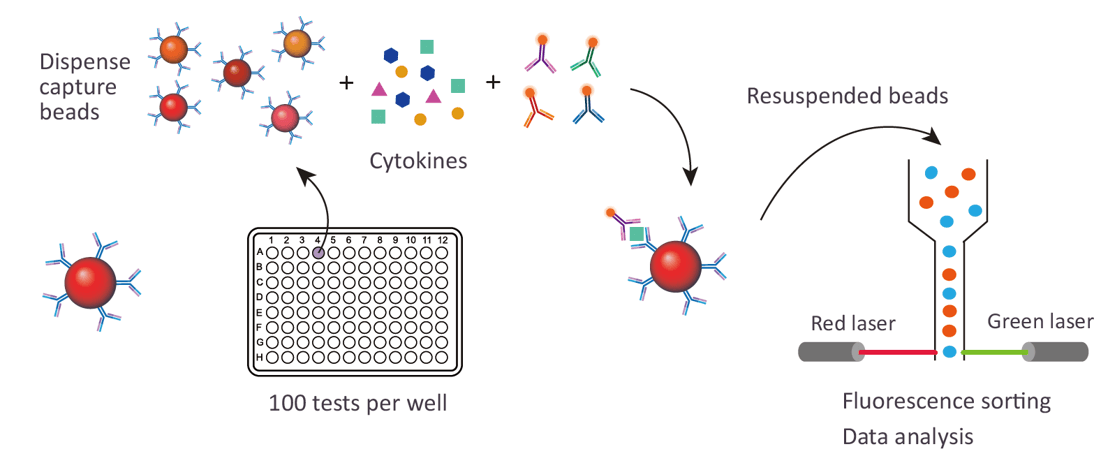Cell culture has become an essential tool in biomedical research for studying cellular processes, disease mechanisms, and therapeutic interventions. The composition of the growth media used in cell culture has a significant impact on cellular physiology and function. Researchers have recognized the importance of the secreted factors, especially cytokines, in cell culture conditioned media, as they play crucial roles in cellular communication and signaling.
Cytokines are small proteins secreted by cells that regulate various physiological and pathological processes, including immune responses, inflammation, and tissue repair. Analyzing the cytokine profile in cell culture conditioned media can provide valuable insights into the cellular microenvironment and help unravel the underlying mechanisms involved in cellular processes. Luminex multiplex technology has emerged as a powerful tool for detecting and quantifying multiple cytokines simultaneously in cell culture conditioned media.
Luminex Multiplex Technology in Creative Proteomics
Luminex multiplex technology is a bead-based assay platform that enables the simultaneous measurement of multiple analytes in a single sample. The technology utilizes microspheres, or beads, that are color-coded with unique combinations of two fluorescent dyes. Each bead population is coated with specific capture antibodies, which can bind to the target cytokines of interest.
Luminex Multiplex Assay Workflow:
a) Bead Coupling: Capture antibodies specific to the target cytokines are covalently coupled to the color-coded microspheres. Each bead population is conjugated with a different antibody, allowing for the detection of multiple cytokines simultaneously.
b) Sample Incubation: The cell culture conditioned media sample containing the cytokines is incubated with the antibody-coupled beads. During this incubation, the cytokines bind to their respective capture antibodies on the beads.
c) Detection Antibody Incubation: Biotinylated detection antibodies specific to the cytokines of interest are added to the sample. These antibodies bind to the captured cytokines, forming a sandwich complex.
d) Streptavidin-Phycoerythrin (SA-PE) Incubation: Streptavidin-phycoerythrin (SA-PE) is added to the sample, which binds to the biotinylated detection antibodies. The phycoerythrin fluorochrome emits fluorescent signals when excited by a laser.
e) Analysis: The sample is analyzed using a Luminex instrument equipped with lasers and detectors. The instrument measures the fluorescence emitted by each bead population, allowing for the identification and quantification of multiple cytokines in the sample.

Advantages of Luminex Multiplex Technology
- Multiplexing Capability: Luminex technology allows for the simultaneous measurement of multiple cytokines in a single sample, significantly reducing time, sample volume, and reagent costs.
- High Sensitivity: The technology offers excellent sensitivity, allowing for the detection of cytokines at low concentrations, even in complex biological samples.
- Wide Dynamic Range: Luminex assays have a broad dynamic range, enabling the quantification of both low and high abundant cytokines within the same sample.
- Small Sample Volume: Luminex assays require only small sample volumes, making them suitable for studies with limited sample availability.
- High Throughput: The Luminex platform is amenable to high-throughput analysis, allowing for the rapid screening of large sample sets.
Applications of Cell Culture Conditioned Media Cytokine Assay
Drug Discovery
Drug candidates' effects on cytokine secretion can be evaluated using Luminex multiplex technology. By observing the effects on cytokine profiles, researchers can evaluate the immunomodulatory capabilities of possible medicinal drugs. This information can be used to find potential medication candidates that alter particular cytokine pathways linked to the condition under study.
Disease Modeling
The technique enables the study of dysregulated cytokine networks linked to diverse diseases in the context of disease modeling. You can learn more about the underlying mechanisms and find possible treatment targets by looking at the cytokine profiles in the cell culture regulatory medium of sick cells or tissues. Multiple cytokines can be concurrently detected and quantified using Luminex technology, giving a complete view of cytokines in disease models.
Basic Research and Preclinical Studies
Analyze cytokine profiles in cell culture condition media, research the function of cytokines in cellular processes and disease pathogenesis, and comprehend the intricate signaling networks that affect cell behavior. This information aids in the development of fresh hypotheses and experimental models as well as a greater comprehension of biological processes.
Biomarker Discovery
By measuring the cytokine profile in cell culture media, you can identify potential biomarkers associated with specific cellular responses or disease conditions. The diagnostic, prognostic or predictive value of these biomarkers can then be further validated and explored.
Immunotoxicity Assessment
In order to analyze the impact of drugs, chemicals, or environmental variables on immune cell function and cytokine release, Luminex multiplex technology is utilized in immunotoxicity investigations. By evaluating cytokine profiles in cell culture-conditioned media, one can determine the possible immunomodulatory effects of different substances and how they can affect immune cell-mediated responses.
Sample Requirements for Cell Culture Conditioned Media Assay
| Sample Collection and Processing | Cell Culture Conditioned Media | Collect from the cell culture system |
| Sample Volume | 25 μL - 100 μL (may vary) | |
| Sample Storage | -80°C (long-term); -20°C or -70°C (short-term); avoid freeze-thaw cycles | |
| Sample Dilution and Compatibility | Sample Dilution | Optimize based on cytokine concentration range |
| Compatibility | Evaluate compatibility between sample matrix and assay reagents | |
| Pre-treatment of Samples | Centrifugation, filtration, or precipitation if needed | |
| Quality Control and Validation | Internal Controls | Include known concentrations of recombinant cytokines as internal controls |
| Assay Validation | Run positive and negative controls; assess precision using replicate measurements |



